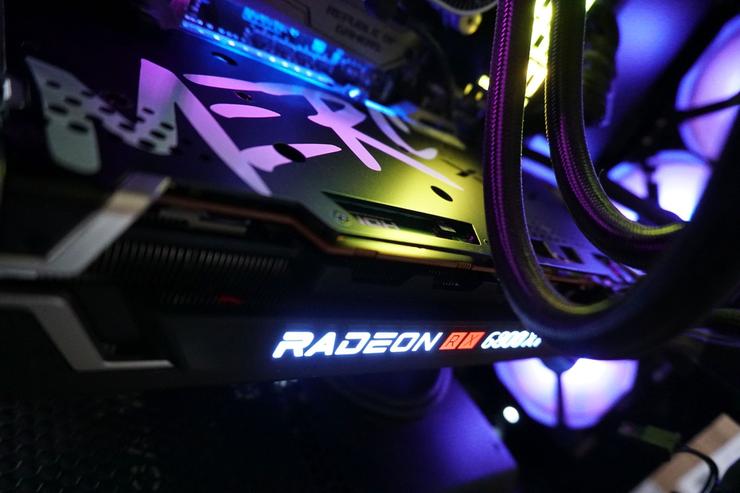 Credit: Brad Chacos/IDG
Credit: Brad Chacos/IDG
Last week the $650 Radeon RX 6800 XT hit the streets and immediately put Nvidia’s $700 GeForce RTX 3080 on notice. For the first time in a long time, AMD’s graphics cards can hang tough with Nvidia’s most powerful offerings. The first wave of Radeon RX 6800-series graphics cards stuck to AMD’s (vastly improved) reference design, but customized versions of the Radeon RX 6800 and 6800 XT hit the streets Wednesday to show us what “Big Navi” is capable of with even more elaborate engineering backing it up.
The $800 XFX Radeon RX 6800 XT Merc 319 (from the company’s new “Speedster” series) doesn’t hold back as XFX’s next-gen flagship. This drool-inducing graphics card packs one of the most gargantuan coolers we’ve ever seen. All that heavy metal helps the Speedster stay utterly silent despite a hefty factory overclock that brings its out-of-box speeds well beyond the 2GHz barrier. Like every RX 6800 XT, XFX’s model packs ray tracing capabilities, the ability to get even faster when paired with Ryzen CPUs, and a massive 16GB memory buffer that dwarfs what you find on rival GeForce GPUs.
But is it really worth a staggering $150 more than the reference Radeon RX 6800 XT? Let’s dig in.
Further Radeon reading:
- 5 key things you need to know about AMD’s Radeon RX 6800 and 6800 XT
- AMD Radeon RX 6800 and RX 6800 XT review: A glorious return to high end gaming
- RDNA 2 deep-dive: What’s inside AMD’s Radeon RX 6000 graphics cards
- AMD Radeon RX 6800 and RX 6800 XT: 3440x1440 ultrawide benchmarks
XFX Radeon RX 6800 XT Merc 319 specs and features
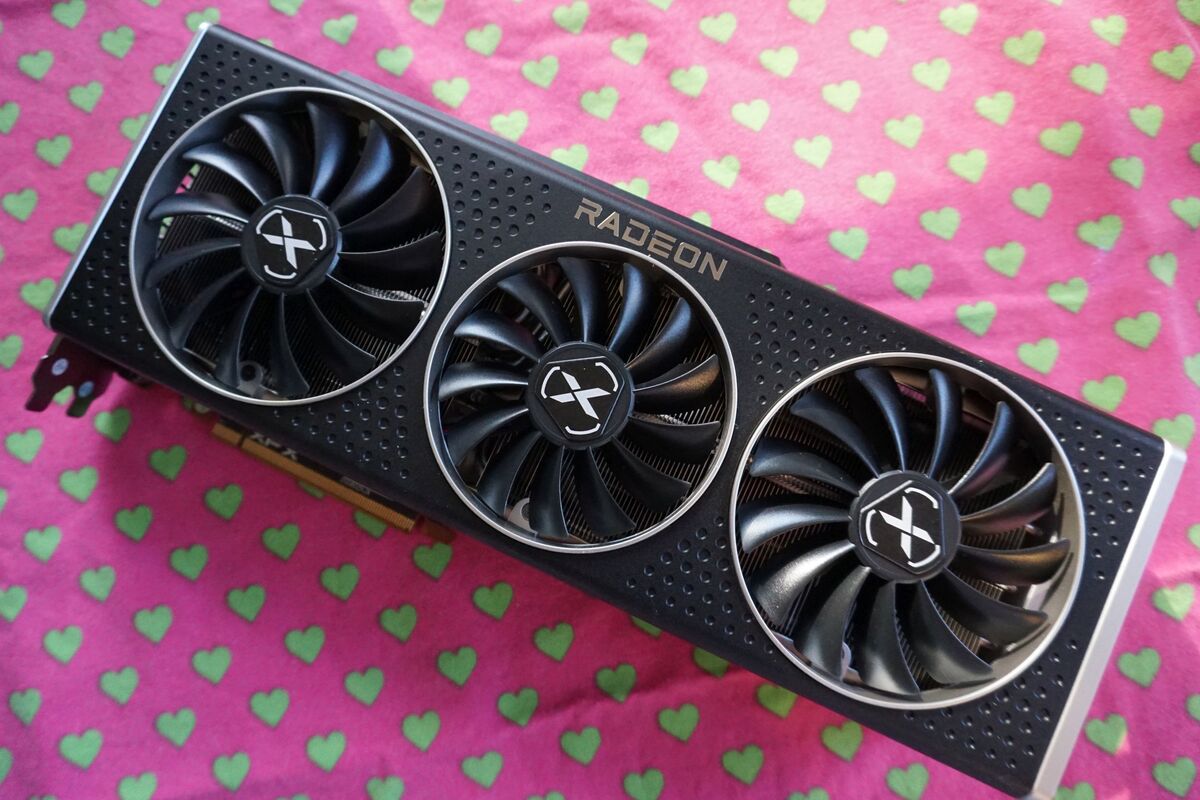 Brad Chacos/IDG
Brad Chacos/IDGUnder the hood, the XFX Merc 319 is built around the same “Navi 21” graphics chip as all Radeon RX 6800 XT models. It’s not the full 80-compute-unit version of the GPU—that’s being reserved for the $999 Radeon RX 6900 XT coming in December—but it’s close, with each of the 72 CUs including a ray accelerator devoted to real-time ray tracing effects.
Here’s a look at the reference specifications for the Radeon RX 6800 XT, alongside the RX 6800 and last-generation’s RX 5700 XT:
 AMD
AMDXFX applies a solid factory overclock out of the box. The Speedster Merc 319 comes with dual BIOS switches. The default “Balanced” BIOS on the right is rated for typical Game Clock speeds of 2090MHz (+75MHz vs. reference) and maximum Boost Clock speeds of 2340MHz (+90MHz vs reference). Flipping over to the “Rage” BIOS on the left adds another 20MHz to those speeds, along with raising the power limit by another seven watts to help push performance even further.
 XFX
XFX
How the XFX Merc 319’s dual BIOSes behave using AMD’s various Radeon Software tuning presets.
XFX’s Rage BIOS takes its name from the new “Rage” power tuning preset in AMD’s Radeon Software, which is available only on the faster XT versions of the Radeon RX 6000-series graphics cards. Enabling Rage mode in Radeon Software cranks the power limit even further—and ramps up the card’s fan speeds to compensate.
The XFX-supplied chart at right shows how the two BIOSes on the Merc 319 behave with the various tuning presets in Radeon Software. If you’re hoping to push performance as much as possible, flipping on both the Rage BIOS and Rage mode in Radeon software will up the overall power limit by a significant 25 watts. That’s before you do any manual tinkering to clocks or voltages.
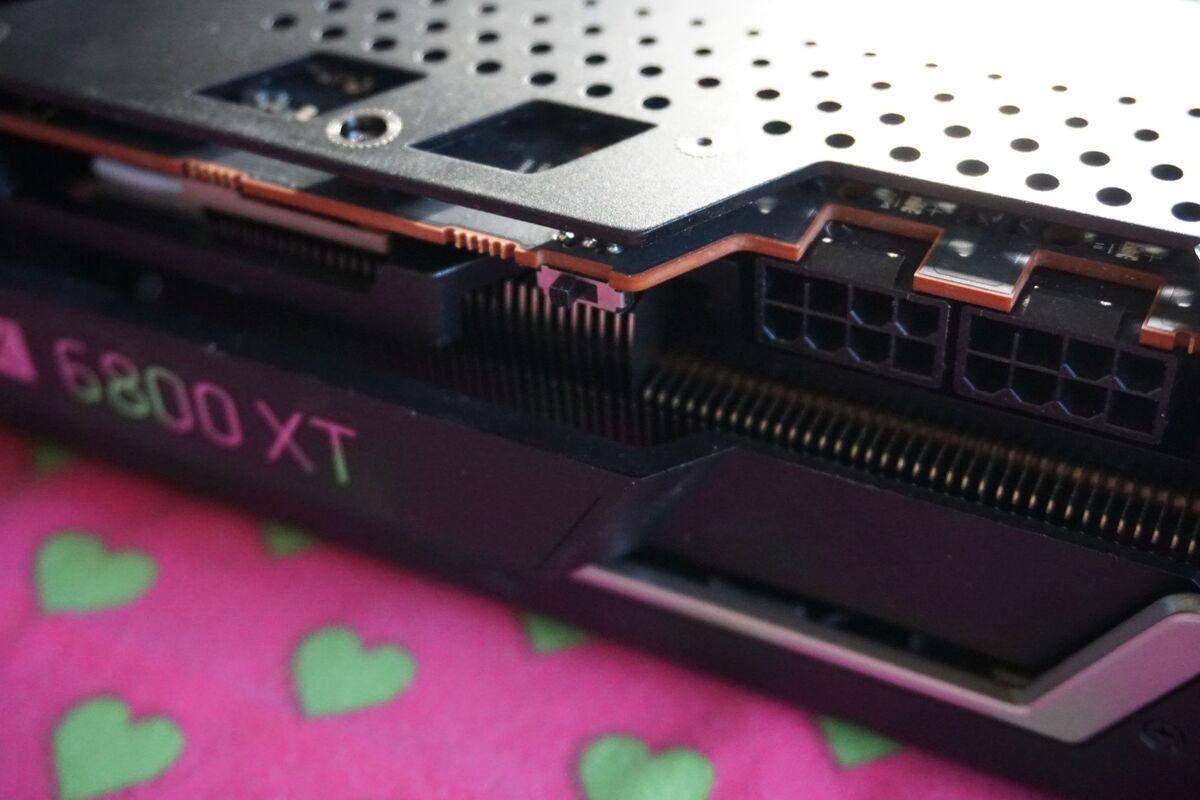 Brad Chacos/IDG
Brad Chacos/IDG
The tiny dual BIOS switch is just to the left of the dual 8-pin power connectors. The default balanced mode is on the right, while the leftmost side activates XFX’s Rage mode.
The XFX Speedster Merc 319 fuels that energy using a pair of 8-pin power connectors, same as the reference Radeon RX 6800 XT. It also features the same display outputs as the reference model, with dual Displayports, a USB-C port that can be used with displays and compatible VR headsets alike, and a single HDMI 2.1 connection with variable refresh rate support. If you’re connecting the XFX Merc 319 to a high-end TV that includes adaptive sync technology, it’ll work just as well as a FreeSync monitor thanks to HDMI 2.1’s inclusion.
XFX Radeon RX 6800 XT Merc 319 design
It’s the custom cooling design of the XFX Radeon RX 6800 XT Merc 319 that enables those higher speeds and power limits.
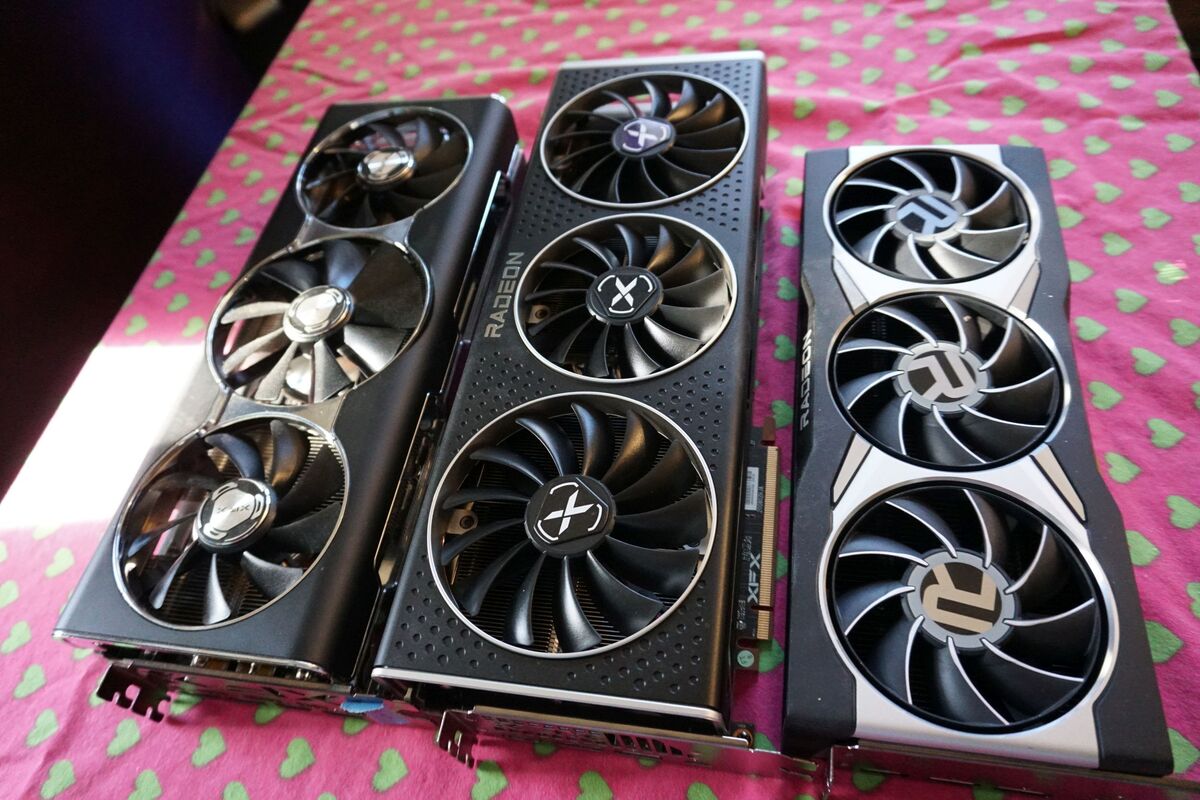 Brad Chacos/IDG
Brad Chacos/IDG
The XFX Thicc III Ultra (left), XFX Merc 319 (center), and AMD Radeon RX 6800 XT reference design (right).
This card is big. XFX’s appropriately named Thicc cards were big last generation, but the Merc 319 is even more massive. (Thicc-er?) It measures a sizeable 13.39 x 5.47 inches, and over two slots deep. Make sure you have room in your case before buying it, but that’s really the case with almost any high-end custom card these days.
This GPU is so long, we actually had to run our power cables over it from our case’s wiring cut-outs, rather than from underneath as we usually do. You’d easily be able to rerun your cables to avoid that in a typical PC that isn’t constantly switching out graphics cards, though.
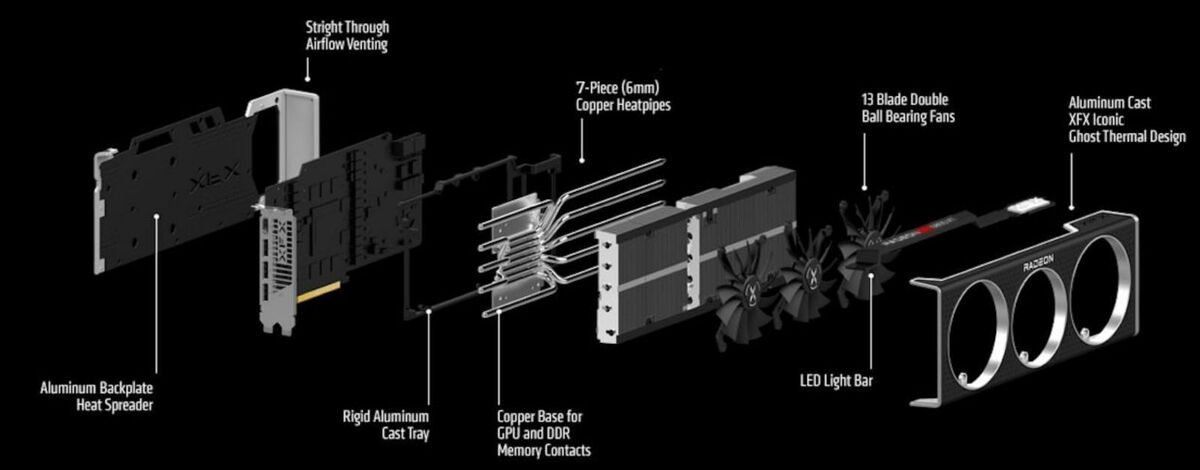 XFX
XFX
A look at the XFX Merc 319’s cooling.
XFX supports that heft with a solid aluminum backplate, an aluminum-cast shroud, and an aluminum “tray” between the PCB and heatsink, all intended to increase the card’s rigidity and combat potential GPU sag. On the GeForce side of things, creators of huge honking high-end graphics cards like the MSI RTX 3080 Gaming X Trio and EVGA RTX 3080 FTW 3 have started to include GPU support brackets in the box. XFX relies on the rigid construction of the Merc 319 instead.
XFX devotes all that space to a cooler that runs totally silent. You can’t hear it over our test system’s case fans and CPU cooler, even during intense gaming loads.
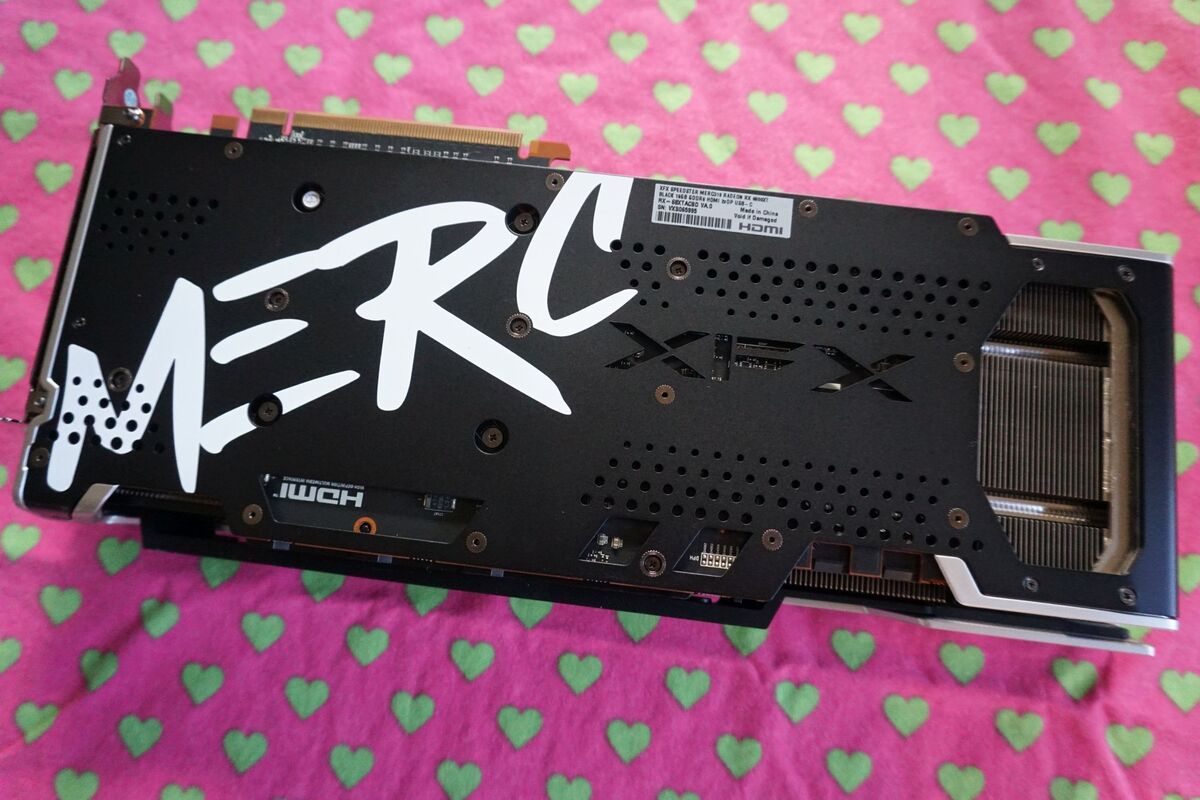 Brad Chacos/IDG
Brad Chacos/IDGThe XFX Radeon RX 6800 XT Merc 319 features a full-length heatsink with a copper coldplate over the GPU and not one, not two, not three, but seven 6mm heatpipes snaking throughout. Three axial fans with 13 blades draw air into that heatsink—dual 100mm fans bracket a slightly smaller, slightly offset 92mm fan in the middle. Swiping a page from Nvidia’s RTX 30-series Founders Edition design, a small cut-out in the backplate on the end of the card allows air to blow clean through the heatsink, maximizing airflow.
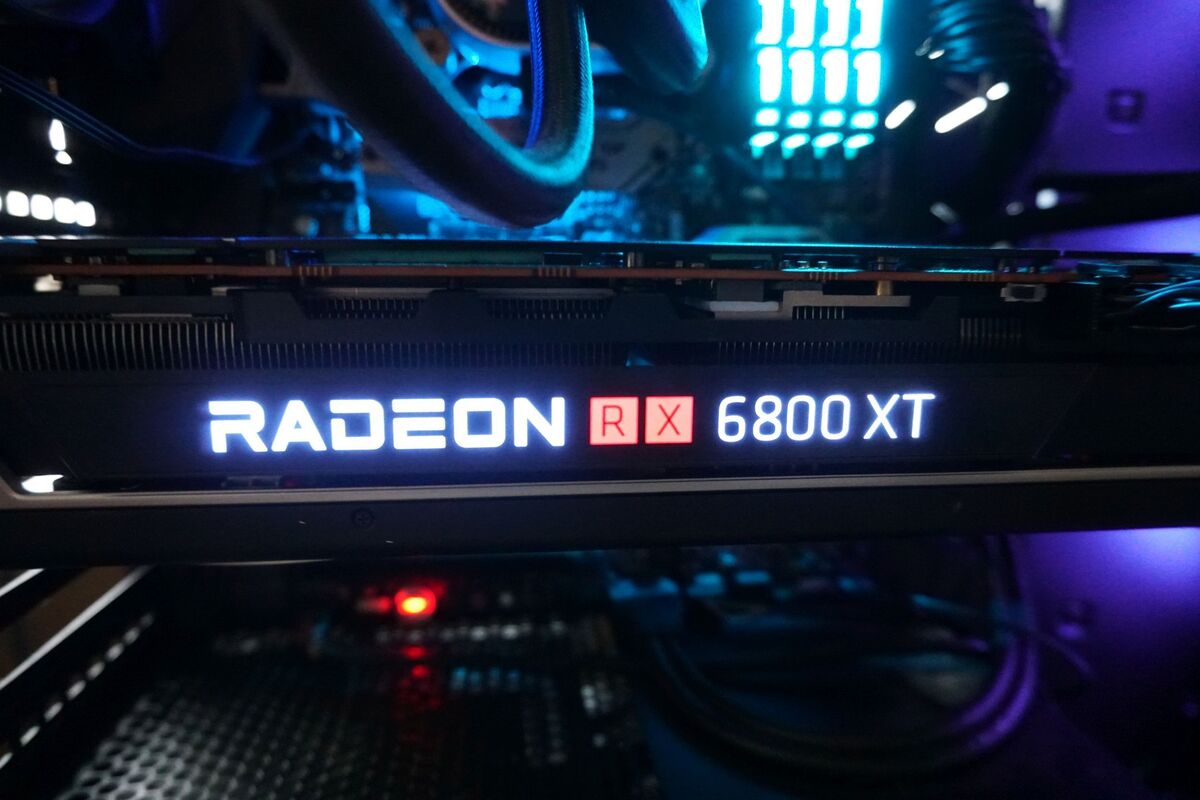 Brad Chacos/IDG
Brad Chacos/IDGWhen images of the card appeared online, some online commentators were worried about the placement of the plastic “light bar” that holds the illuminated Radeon RX 6800 XT logo on the outer edge of the XFX Merc 319. From the side, it looks as though the plastic bar significantly blocks airflow on that side of the card, which could impede cooling efforts. Fear not! XFX protrudes the bar by about a third of an inch to allow air to escape, and the heat sink is unfettered on the opposite side. Ditching it could possibly improve cooling, but that would also affect the sleek aesthetic this card aims for. In any case, the cooler is effective enough that the card runs unheard.
 XFX
XFXRather than using AMD’s default PCB for the Radeon RX 6800 XT, XFX actually equipped the Merc 319 with the circuitry intended for the step-up Radeon RX 6900 XT for better power delivery, and built the card with a 14+2 power phase design rather than the stock 10+2. The company also applied 20 different thermal pads over various interior components to improve temperatures for the 16GB of GDDR6 memory, voltage regulation, and more.
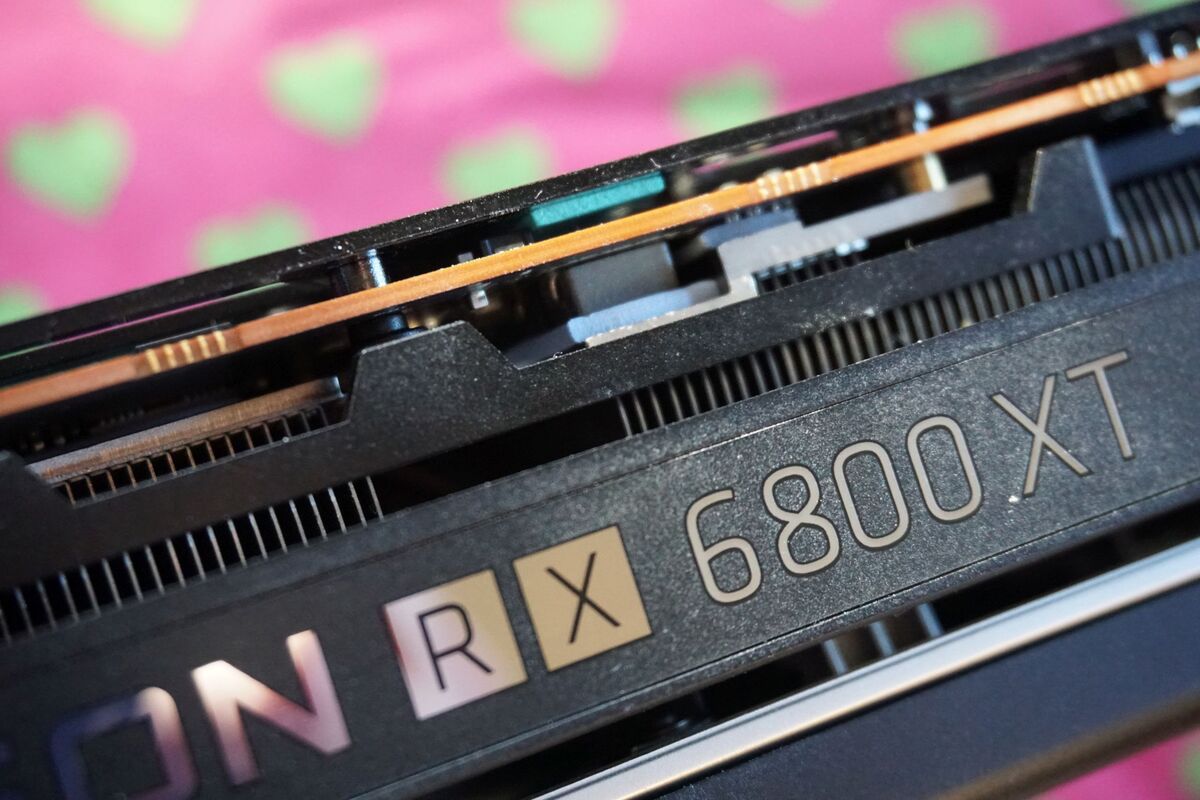 Brad Chacos/IDG
Brad Chacos/IDGYou can see some of the thick pads looking into the edge of the card, as shown above. That includes putting thermal pads on the rear of the PCB, allowing the aluminum backplate to double as a heatsink—a practice we’ve seen on some other cards.
XFX is known for its aggressive-looking designs. Last generation’s Thicc models, for instance, evoked the feel of muscle cars of yesteryear. The Merc 319 refines that aesthetic. I love the industrial black-and-silver vibe of this card, and RGB haters won’t find an ounce of unicorn puke anywhere.
The XFX and Radeon RX 6800 XT logos on the side are illuminated though, and in a surprisingly striking fashion. Their white lights (red, for the “RX” lettering) shine much more cleanly and clearly than the logos do on rival graphics cards—sort of like the difference between standard car headlights and LED headlights. These pictures don’t capture how nice it looks.
 Brad Chacos/IDG
Brad Chacos/IDGThen there’s the logo. XFX emblazoned the word “Merc” in big, stylized white letters across the top of the backplate. It definitely fits the vibe of the card, as well as XFX’s general branding, but if you prefer your hardware to look less “edgy,” you might not appreciate it. There’s no way to avoid seeing it if your case includes a tempered glass side panel. Me? I dig it. Your mileage may vary. And what does “Merc 319” mean, anyway? Here’s what XFX told me:
“MERC stands for Mercury (not mercenary), and 319 relates to fan configuration. 3 = Number of Fans, 1 = 100mm, 9 = 90mm. If we were to have a 2 fan model with 100mm fans the number would be 210. So there is some reasoning behind the name, and it’s not a random number. For the foreseeable future MERC will be our flagship model with all best features and upgrades.”
But enough chit-chat. Let’s get to the benchmarks.
Next page: Our test system, benchmarks begin

















